
Weight Gain Meal Plan for Women: Full Guide
Gaining weight can be hard for naturally thin women. It’s even harder if you’re trying to gain weight in a healthy and sustainable way. We’ve been there. We’ve helped thousands of other women through it, too. It’s hard, but you can do it, and this guide can help.
One of the hardest things about gaining weight is finding a good meal plan. Most meal plans are designed for women trying to lose weight. Your goal is the opposite of that, so you need a radically different approach.
In this article, we’ll talk about how to eat a healthy weight-gain diet. We’ll break down the best foods, how to eat a balanced muscle-building diet, what schedule to follow, and how to build a meal plan that works for you, your goals, and your lifestyle.
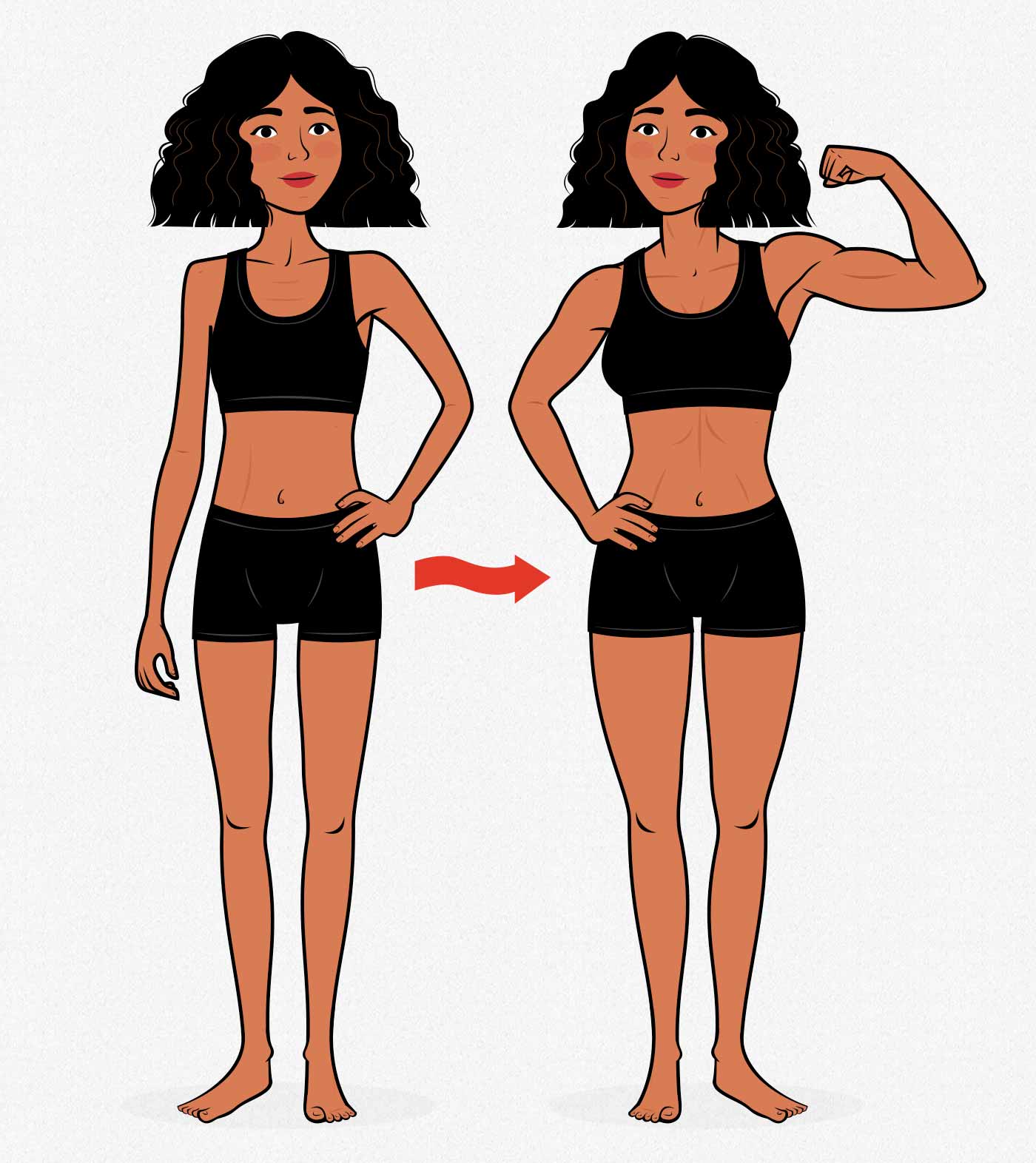
Overview
The Basics of a Healthy Weight-Gain Diet
To gain weight, you need to get into a calorie surplus. That’s easier said than done, I know. Thin people often have faster metabolisms, making it harder to eat enough food to gain weight. It’s a blessing and a curse.
- Eat more snacks: The easiest way to get into a calorie surplus is to eat more often, adding snacks between your main meals. Even better if those snacks are high in calories. Think of trail mix, smoothies, bananas, and nuts.
- Eat high-calorie foods: It also helps to choose high-calorie foods, such as bananas over berries, peas over broccoli, or ground meat over chicken breast.
- Drink your calories: Smoothies are packed with nutritious calories, aren’t very filling, and digest quickly. Protein shakes aren’t as nutritious, but they’re a great way of adding calories and protein to your diet. They’re especially handy if you’re following a plant-based diet. If you need to, you could even use a weight gainer. You can maximize recovery after lifting by having a post-workout shake or smoothie.
Weigh yourself every week. If you’re gaining 0.25–0.5 pounds, great—keep going. If you aren’t gaining weight, add a little more food to your diet. Add another snack or eat slightly larger meals. Keep weighing yourself and adding more food as needed.
Lift Weights to Build Muscle
You should also weights. Lifting weights can radically improve the muscle-to-fat ratio when gaining weight. For example, if you gain 10 pounds while being sedentary, around 2/3rds of that weight will be fat. But if you gain 10 pounds while following a good resistance-training program, almost all of the weight you gain can be muscle.
You can build that muscle where you want it. If you want bigger hips and thighs, focus on training your lower body. If you want toned arms and nice shoulders, focus on your upper body instead. If you want to build a great body overall, follow a balanced workout program.
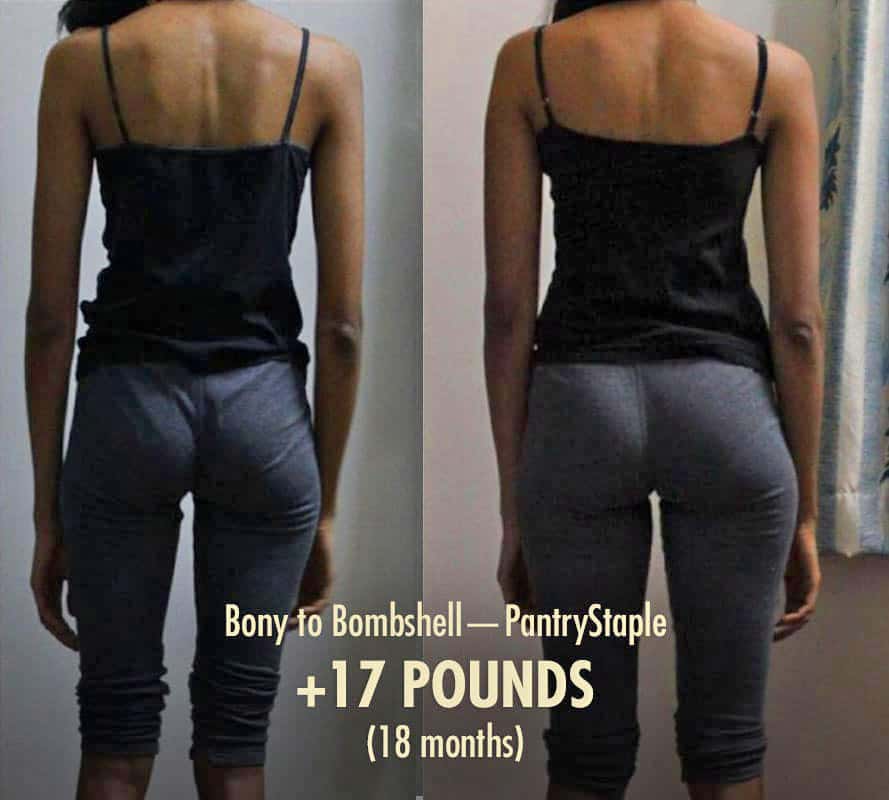
The Ideal Calories and Macros for Gaining Weight
To start gaining weight, you will need to get into a calorie surplus. Here are three main ways you can get into a calorie surplus:
- Calorie counting: You can estimate how many calories you’ll need to gain weight by plugging your weight, body-fat percentage, and activity levels into a simple weight-gain calorie calculator. If you want to track your calories with an app, we’re affiliated with MacroFactor. It’s one of the few calorie-tracking apps that’s made for people trying to build muscle and gain weight. You can use the code “b2b” for an extended free trial. By the end of that free trial, you’ll know everything you need to know about your calorie needs.
- Adding calories: You don’t need to know how many calories you’re eating. All you need to do is get into a calorie surplus. To do that, you can add calories to the diet you’re already eating. You’ll need 200–300 extra calories to gain 0.25–0.5 pounds per week. This works well for women who eat similar meals at similar times every day.
- Eating 10–15% more: if you don’t want to think about calories at all, you can simply think about eating more. If you increase the size of your meals by 10–15%, or if you add a small snack to your day, that will get you into a reasonable calorie surplus. This works best if your diet is fairly consistent from day to day.
Understand, this is just a starting point. You’ll need to weigh yourself every week, see if you’re gaining weight, and add more calories to your diet as needed. Everyone’s metabolism is a bit different. You need to weigh yourself and adjust. (I know we’ve said this already, but it’s important!)
How to Track Your Weight Gain
A common beginner mistake is to fail to gain weight, assume your initial calorie estimates were off, and then go back to the drawing board, redoing your initial calculations. That won’t help. Once you start weighing yourself, we have real results to look at. It’s time to start listening to your body.
- If you’re not gaining weight, add 100–200 calories.
- If you’re gaining weight too fast, remove 100–200 calories.
Here’s where things get tricky. Your weight fluctuates throughout the day (and month). If you weigh yourself after dinner and again after waking up, you’ll have lost a few pounds. You’ve breathed out some of your hard-won weight. Or at least that’s what it feels like.
Here are a few tricks for tracking your weight gain:
- The first week is a wildcard. Hold steady. When you first start eating your weight-gain diet, you’re adding food into your digestive system, inflating your muscles full of glycogen, and adjusting to a new intake of salt. It’s common to see the scale jump 1–3 pounds. And that’s great. Don’t make any adjustments yet. Wait until next week. Let’s see how things settle.
- Always weigh yourself at the same time of day, controlling for as many variables as possible. For example, weigh yourself every Sunday morning after peeing and before having anything to eat or drink.
- If you’re somewhat close to the ideal pace, you’re good. If you aim to gain 0.5 pounds each week but gain 0.3 or 0.8 pounds instead, that’s great. Those small discrepancies are well within the realm of natural fluctuations. You don’t need to adjust anything. Keep it up.
- There will come a time when your weight gain will slow. Every pound of muscle you gain will burn around 12 calories per day. As your body adjusts to a higher calorie intake, your metabolism might increase by even more than that. That’s okay. Keep weighing yourself and adjusting accordingly. (And don’t worry, when you stop trying to gain weight, you can go back to listening to your appetite! This isn’t forever.)
How Much Protein, Carbs, & Fat to Eat
Food is made of energy. That energy comes from three different “macronutrients” or “macros:” protein, fat, and carbohydrates. Each macro is an important part of a balanced diet, and each contributes to muscle growth in its own way.
- Protein: Muscle is built out of protein. Aim for at least 0.7 grams of protein per pound bodyweight per day. So if you weigh 120 pounds, you want to consume at least 84 grams of protein. That’s 21 grams of protein split up over 4 meals.
- Carbs: Carbs are the most efficient form of energy. They’re stored in our muscles as glycogen, making us look more muscular and improving our workout performance. Eating plenty of carbs gives your muscles more fuel, allows them to work harder, and helps them grow faster (full explanation). Think of carbs like legumes, dairy, whole grains, fruits, vegetables, and honey.
- Fat: Fats play a crucial role in hormone regulation, absorption of fat-soluble vitamins, and overall health. Focus on sources like fatty seafood, extra-virgin olive oil, avocados, nuts, and seeds. Most women already eat enough fat. Eating even more is a good way of getting into a calorie surplus.
The simplest way to eat a healthy muscle-building diet is to include a source of protein in every meal, ensure you’re eating enough protein overall, and then fill in the rest of your diet with nutritious carbs and fats.
Focus on Eating Balanced Meals
It’s common for bodybuilders to focus on protein or for overweight people to worry about carbs. You don’t need to fixate on any one macronutrient. Instead, try to eat balanced meals that include a nice mix of all of them.
If you imagine a nutritious meal, you probably have the right idea. Maybe you’re thinking of salmon with roast potatoes and asparagus. Maybe you’re thinking of a yogurt parfait. Maybe you’re imagining a stew or paella. These meals all contain protein, carbs, fats, fibre, and micronutrients. That’s what a balanced meal looks like.
If you take the potatoes off the plate, you’re missing carbs. If you remove the salmon, you’re missing protein and healthy fat. If you remove the asparagus, you’re missing fibre and reducing the number of micronutrients in your meal. Every part of the meal is important. That’s why we want to think of whole, balanced meals.
Healthy Weight-Gain Foods
When trying to gain weight, focus on nutrient-dense, calorie-rich whole foods. The problem is, many whole foods are notoriously filling, making it harder to eat enough calories. Broccoli is great, but it won’t help you gain weight. We need to find whole foods that are denser and higher in calories.
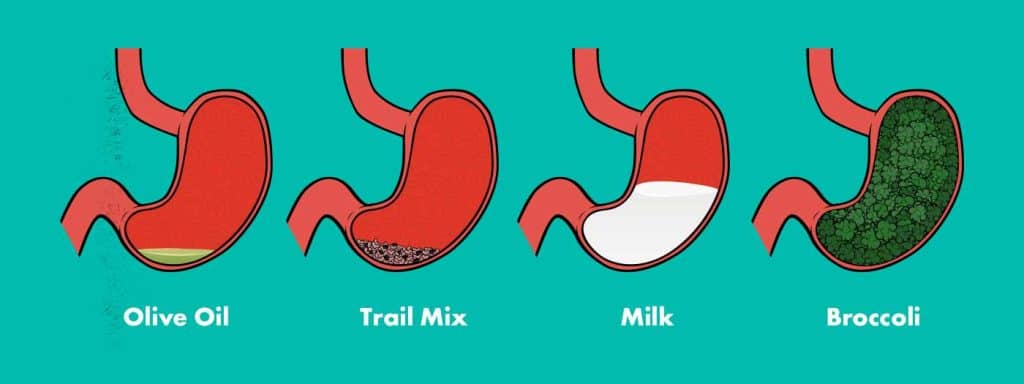
So it’s essential to make wise choices about which nutritious foods you design your weight gain plan with. This next section will provide you with a variety of healthy food options that will help you gain weight. But if you want a deep dive, we have a full article on the best bulking foods.
The Best Protein Sources For Gaining Muscle

- Lean cuts of meat (including lean ground meat). Think of chicken breast, turkey breast, and leaner cuts of steak. You get the same nutrients if you grind it into lean ground beef, but it’s easier to chew and digest.
- Fish. Salmon, cod, tuna, and sardines are nutritious ways to add protein to your meals.
- Dairy: think of high-protein dairy like kefir, greek yogurt & cottage cheese.
- Soy. Soy is high in protein and can be nutritious when eaten in moderation.
- Eggs, legumes, nuts, seeds, peas, and whole grains all contain some protein. They’re not as high in protein as the other sources, but it can add up quickly.
Healthy Sources of Fat

- Oily fish: Wild salmon, sardines, mackerel, and fish roe. All are great sources of healthy fats. They’re also rich in the omega-3 fats EPA and DHA, which most of us could use more of.
- Extra Virgin Olive Oil: Rich in monounsaturated fats and antioxidants, olive oil can be used for cooking, salad dressings, or drizzled over veggies before popping them in the oven.
- Avocados: A calorie-dense fruit rich in healthy fats, avocados are an excellent addition to your meals and salads. Guacamole is a great high-calorie dip. You can also add avocados to your salads, tacos, and even smoothies.
- Seeds, nuts, and nut butter: peanuts, pumpkin seeds, almonds, and soybeans are all rich in healthy fats, high in protein, and packed with micronutrients. That includes nut butter like peanut butter and almond butter.
Nutritious Carbohydrates

Carbohydrates are vital for providing energy and work great for building muscle.
- Oats. Oats are a classic food among bodybuilders. They’re high in nutritious carbs, fibre-rich, and relatively easy to prepare. Oatmeal and overnight oats make for great breakfasts.
- Rice. White rice is easy to prepare and quick to digest, whereas brown rice is higher in fibre, protein, and nutrients, which is great for your health and digestion.
- Fruits. Tropical fruits like bananas and mangoes are especially high in calories, but all fruits are nutritious and good for gaining weight.
- Dried fruits. You get all the nutrients of fruit in a much smaller package, making it easier to fit into your stomach. Think of trail mix, dried cherries or mangoes, raisins, and prunes.
- Honey. Honey makes for a fantastic high-calorie sweetener. It’s an incredibly dense source of carbs and calories. It’s also quite rich in nutrients.
Creating a Weight Gain Meal Plan
To create your own weight gain meal plan, it’s essential to incorporate healthy, calorie-dense and high-protein foods into your diet. Start by calculating your daily caloric needs and adding 250 extra calories to promote gradual, healthy weight gain. Getting into a calorie surplus could be as simple as taking what you’re already eating and just adding an extra glass of milk with a couple of meals. Or have a handful of trail mix as a snack. Or you could track calories if you like eating similar foods every day.
Here are some basic guidelines for your meal plan:
- Aim for 4–7 meals or snacks throughout the day. Spreading your calorie intake out will save you from eating enormous meals that weigh down your spirit and body.
- Include a protein source in every main meal. Think of lean meats, fish, eggs, dairy, nuts, seeds, beans, lentils, and soy.
- Add nutritious carbs and healthy fats. You don’t need to be precise. Make meals that taste good and leave you feeling great.
Meal Prepping and Planning
Gaining weight is hard for people like us. We need to take it seriously. We can’t ever let ourselves fall behind on calories. If we do, we’ll be forced to eat more in subsequent meals, leading to hours of feeling bloated on the couch, wishing we hadn’t skipped our mid-morning smoothie.
That’s where meal planning and meal prepping come in. You need to have enough food in your fridge and cupboard. You need to set aside time to cook. You need a fridge stocked full of healthy leftovers and premade snacks.
By preparing meals in advance, you’ll save time and energy and ensure you always have nutritious options at your fingertips.
- On Sunday, plan out your meals for the week. Draft a menu for breakfast, lunch, dinner, and snacks using the guidelines provided above. Don’t forget to account for variations based on your preferences, dietary restrictions, and activity levels.
- Create a grocery shopping list. List all the ingredients you’ll need for the week. Remember, prioritizing protein and easy-to-eat calories is crucial.
- Make time for meal prep. Set aside a dedicated block of time, ideally on the weekend, to prepare meals and snacks for the week.
- Store your meals properly. Use airtight containers to separate and store your prepped meals or ingredients in the refrigerator and freezer to keep them fresh throughout the week. Label each container with the contents and the date it was prepped. We’re big fans of glass storage containers as they clean well and can be popped into the oven without dirtying more dishes.
We are big fans of cooking bulking meals in bulk. When we make chili or picadillo, we make 8+ servings. Here are some meals that make great leftovers:
- Chili
- Picadillo
- Lentil stew
- Any type of stew
- Homemade protein bars
Increasing Meal Frequency
You’ll need to eat more calories than your body burns to gain weight. You could increase meal sizes, but we’re fighting against the harsh reality of tiny stomachs and finicky digestive systems. The easiest way to eat more food is to eat more often. If you’re eating 3 meals a day, try adding snacks between them.
These snacks can be simple. Grab a homemade protein bar from the fridge. Crunch on some carrots dipped in hummus. Maybe slice up an apple and dip it in peanut butter. Make a quick parfait from Greek yogurt, berries, and honey (or dark chocolate chips). If there’s a Starbucks nearby, grab a latte. Tons of great options.
Weight Gain Meal Planning With Food Intolerances
If you have food intolerances or allergies, meal planning becomes even more important. You need to make sure you always have the right types of food on hand. Here are some tips to help you plan meals that meet your needs:
- Research alternative ingredients. There are many alternative ingredients available that can be used in place of common allergens. Swap milk for soy milk or oat milk. Swap whole grains for fruits. Swap whey protein for a plant-based protein powder.
- Focus on the foods that suit you. Eat more of the foods that make you feel good. If we suggest Greek yogurt with berries, but you already have a healthy snack you enjoy, keep eating that snack. Eat the diet that suits you.
Supplements and Weight Gain Shakes
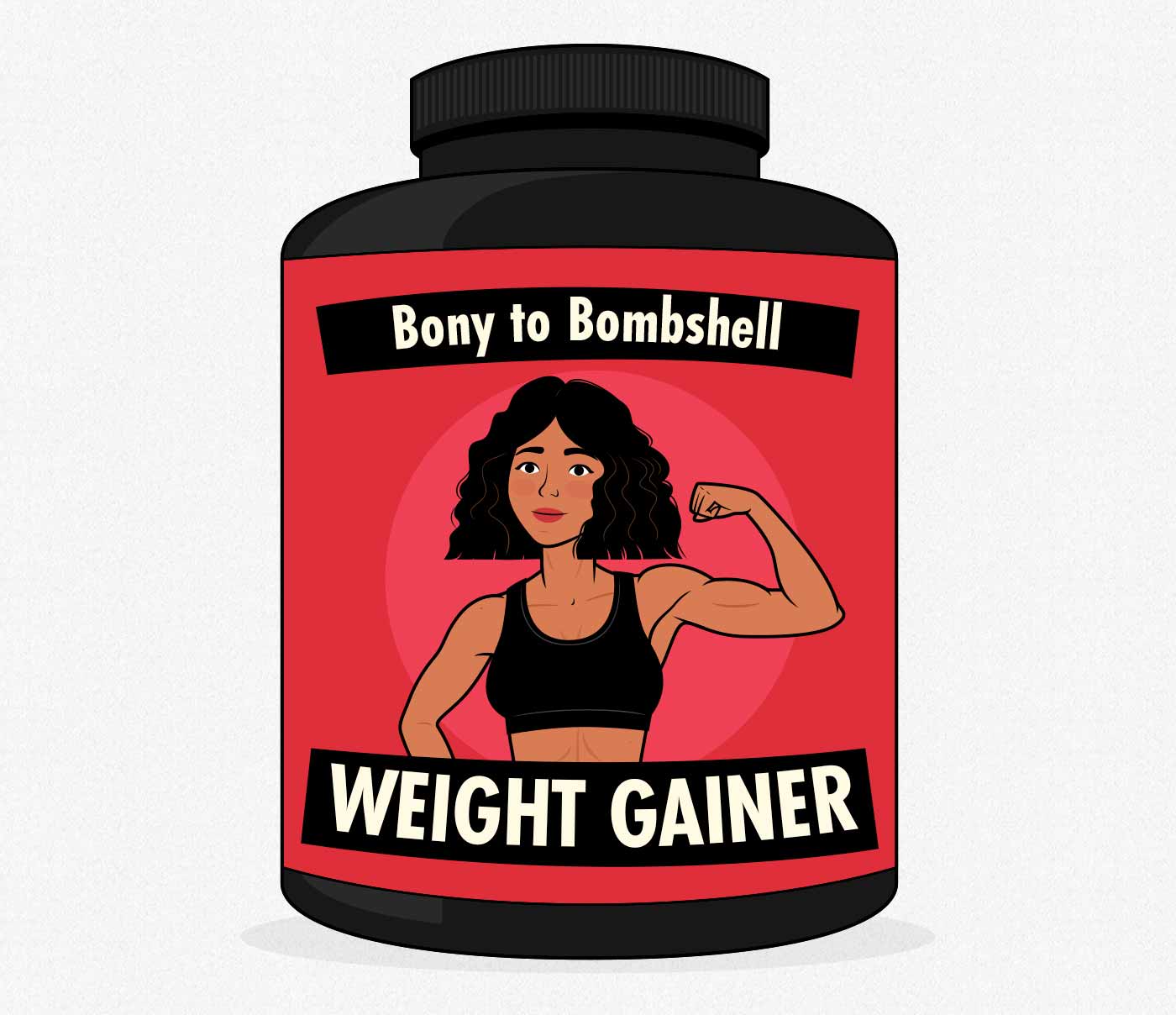
Protein Powder Supplements
Incorporating protein powders into your meal plan can be a convenient way to ensure you’re meeting your daily protein needs. They can be added to smoothies, oatmeal, and baked goods for an extra protein boost. Various protein powders are available, such as whey, soy, and plant-based options.
Here are a few popular protein powder options:
- Whey protein powder. Derived from milk, it’s quickly absorbed by the body and contains all essential amino acids. Whey is a tried-and-true classic. It tastes faintly milky.
- Plant-based protein powders. Combinations of proteins like soy, pea, rice, and hemp. These blends contain a balanced mix of amino acids, making them perfect for building muscle. They tend to taste earthy.
Weight Gainer Shakes For Women
Weight-gainer shakes can help you consume more calories in a convenient, easy way. The problem is they’re made from extremely processed ingredients. I’ve used them. Plenty of thin people do. You can, too. But there’s a better way.
Instead of buying a pre-made supplement, we recommend blending up a weight-gain smoothie. That way, you get all the easy-to-drink calories of a weight gainer shake while getting all the nutrients in fruits, nuts, yogurt, and leafy greens.
To further increase the calorie content of the smoothies, add ingredients like nut butter and quick oats. Remember to include fruits and vegetables for added fibre, vitamins, minerals, and antioxidants. Here’s a simple recipe for a nutritious, calorie-dense weight-gain smoothie.
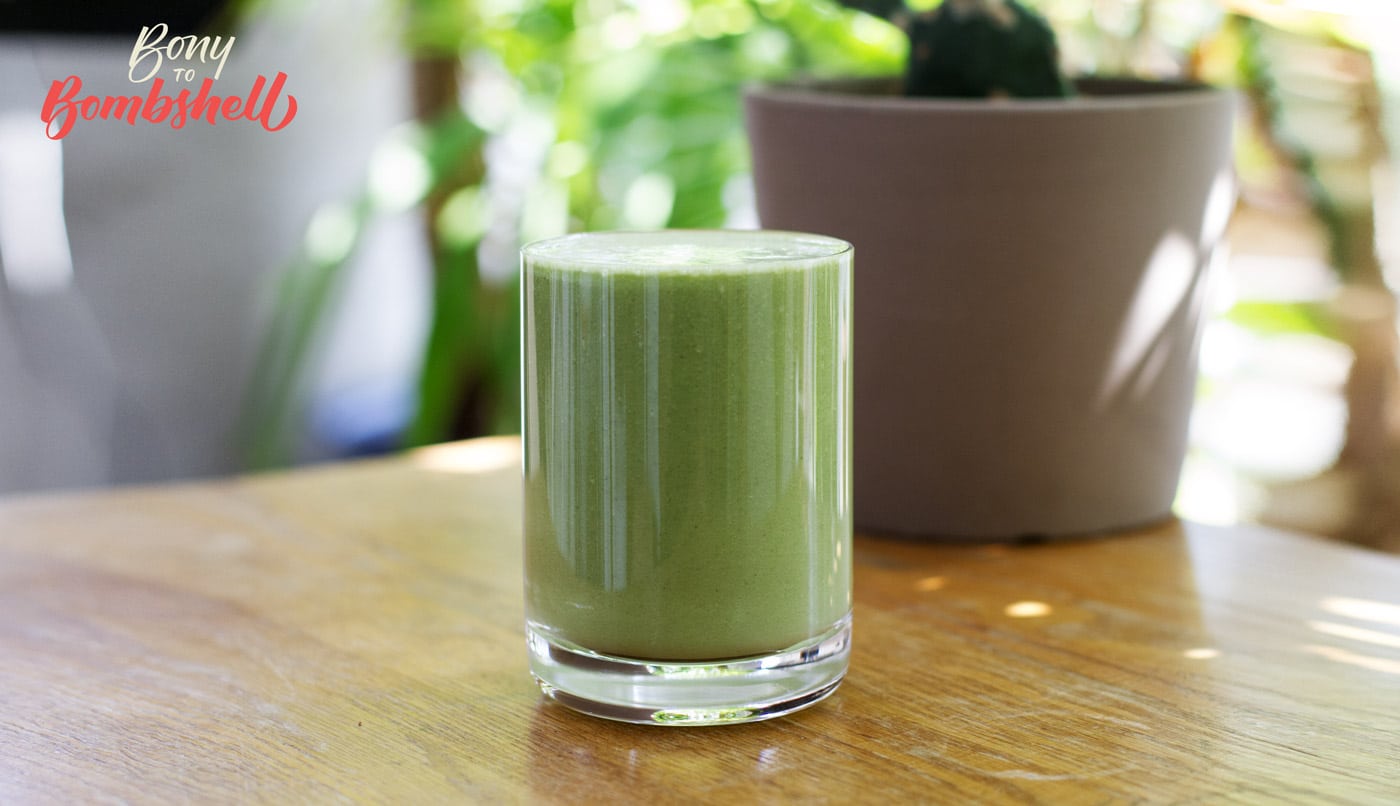
- 225ml of water, milk, or a milk alternative.
- 1 banana
- 1 tablespoon of almond butter
- 4 frozen strawberries
- 1 scoop of protein powder or half a cup of Greek yogurt
- A handful of fresh spinach
If you’re using protein powder, I recommend blending the other ingredients together first. Once everything is blended smoothly, add the protein powder and blend it for a few more seconds. This will prevent the smoothie from frothing up. Frothy smoothies have more air, taking up more space in your stomach and making you gassy.
GET THE sample PDF recipes OF THE
weight-Gain Muscle-building Smoothies
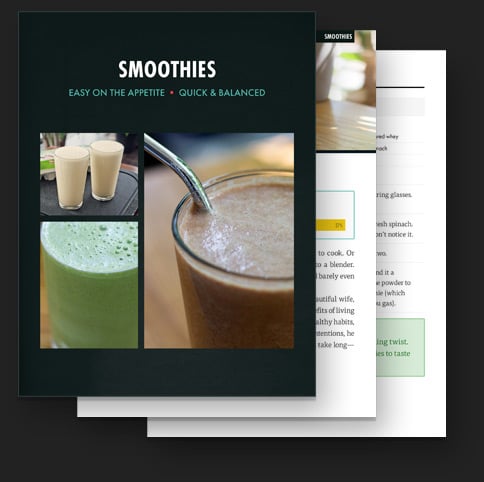
Get some sample smoothies recipes in a downloadable PDF file. Get the full explanation, ingredient list, macros, and steps to follow.
Plus, we’ll make sure you’re on the Bony to Bombshell newsletter, and send you all of our best women's muscle-building content.
To add variety to your meal plan and avoid getting tired of the same flavours, experiment with different combinations of fruits, nut butter, vegetables, and protein powders in your smoothies. Remember to keep the overall calorie and nutrient content in mind as you design your weight gain meal plan.
Sample Meal Plan
When Cassandra and I first met, I was eating reheated chili twice per day. She was horrified. She said there wasn’t nearly enough variety in my diet. And she was right.
When we moved in together, I noticed the chaos of her fridge. Every drawer was full of half-portions of wilting plants. She repeated recipes so infrequently that her ingredients would go bad before she got a chance to use them again.
Over the past decade of helping women gain weight, we’ve noticed that more of them tend to be like Cassandra. There’s a healthy middle-ground here. Find staple meals you enjoy and eat them as often. But also put in the effort to build some variety into your diet. Have a few different types of snacks around. Plan a few different dinners for the week.
Eating a relatively consistent diet is the easiest way to gain weight at a steady pace. If you stop gaining weight, you can make your meals slightly bigger or add another snack. You don’t need to eat the exact same foods every day but try to eat similar serving sizes on a similar schedule.
Sample Full-Day Weight Gain Meal Plan
Here’s a sample meal plan to give you an idea:
- Breakfast
- Coffee
- Smoothie (or a yogurt parfait or overnight oats)
- Snack One
- 1 cup of baby carrots with hummus (or a homemade protein bar)
- Lunch
- Grilled chicken breast with roasted vegetables drizzled with extra virgin olive oil and 1 cup of rice. (Or some leftovers.)
- Snack Two
- 1 apple with 1 tablespoon of peanut butter. Add a dash of honey and cinnamon to the peanut butter if you want. (Or have a serving of trail mix.)
- Dinner
- Oven-baked salmon, potatoes, and asparagus, all tossed in spices and olive oil. (Or cook up a big pot of chili or lentil stew.)
- Snack Three—Pre-bed
- Greek yogurt with mixed frozen berries and some honey. For extra flavour, add some cinnamon, vanilla, or dark chocolate chips.
This sample meal plan includes a variety of high-protein foods (chicken, salmon, Greek yogurt, and nuts). It also contains nutritious carbs like rice, potatoes, yogurt, berries, fruits, and honey. And it has healthy fats from the salmon, nuts, and olive oil.
Adding Variety to Your Diet
For variety, you can tweak a few things to your daily plan while staying consistent. For example:
- Swap the almond butter for peanut butter on the toast.
- Swap out the type of roasted veggie you eat with lunch.
- Instead of eating an apple, eat a pear or another type of fruit.
- If you get tired of salmon, have chicken or lean ground beef.
- Maybe have stir fry for dinner. If you get sick of that, have some sushi.
There are no hard rules. Choose meals you like. Build a meal plan you look forward to eating. Make small swaps to keep it feeling fresh and interesting. And if you stop gaining weight, add more calories.
Conclusion
Remember: when planning your meals, in almost every circumstance, it all comes down to eating balanced meals, eating nutritious foods, eating enough protein, and getting into a small calorie surplus every day. If you can do that, you’ll gain weight, guaranteed.
If you liked this article, you’d love our muscle-building newsletter. We’ll keep you updated on all the latest muscle-building information for women. Or, if you want us to walk you through the process of building muscle, including teaching you the lifts, giving you an entire workout program, a complete diet guide, a recipe book, and online coaching, check out our Bony to Bombshell Program.



FREE women's Muscle Growth MINI-COURSE
Get our 5-part female bulking mini-course that covers everything you need to know about:
Here are some related articles